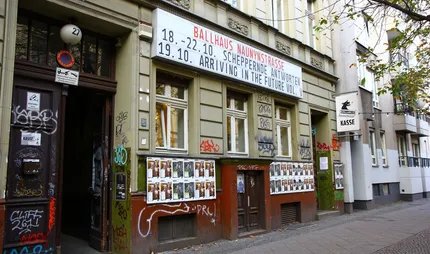
Ballhaus Ost
Bravely going where few would dare
Located in an idyllic rear courtyard, the ivy-covered brick of Ballhaus Ost houses one of the most diverse stages in all of Berlin. This is a centre for experiment.
Ballhaus Ost is in an ivy-covered brick chapel in a small cemetery park in Berlin's Prenzlauer Berg districtt. This little hideaway between Pappelallee and Lychener Straße looks more like an idyllic green courtyard than one of the most multifaceted theatres in the city. What served as a billiards hall and dance club in the years after unification has become a very busy theatre and performance stage with more than 100 events each year. Berlin's independent theatre scene knows no rest and there's always something to see at Ballhaus Ost.
The old ballroom with herringbone parquet and metre-high windows has hosted plays, dance performances, performance art, and readings since 2006. Pieces from the visual arts, dance, drama, science, and music come together in various combinations all under one roof to give a fascinating insight into different aspects of contemporary theatre. Ballhaus Ost is now the permanent home for Berlin's independent theatre scene.
More than just theatre
Ballhaus Ost was founded in 2006 by directors Uwe Moritz Eichler, Philipp Reuter, and Anne Tismer. Tismer made a name for herself in Berlin with her production of Henrik Ibsen's Nora at the Schaubühne on Lehniner Platz.
After extensive construction work, the 1907 former church hall of the Free Religious Community in Berlin became a dynamic place for experimental theatre.
The structure's charm and history were preserved, with the painted walls fading and peeling and floor boards that have endured much abuse over the decades. The house has been managed by Daniel Schrader and Tina Pfurr since 2011.
Experiments on stage
In addition to voice and dance theatre, performance art, readings, concerts, and lectures are scheduled at Ballhaus Ost. In particular, festivals and interdisciplinary art projects, such as the squatting installation/spectacle/performance by Osteuropa-WG Kommunalka in June 2010. Artists regularly taking the Ballhaus Ost stage include the established puppet theatre Das Helmi and the Lubricat theatre group. Young artists also get the chance to perform in front of curious audiences.
